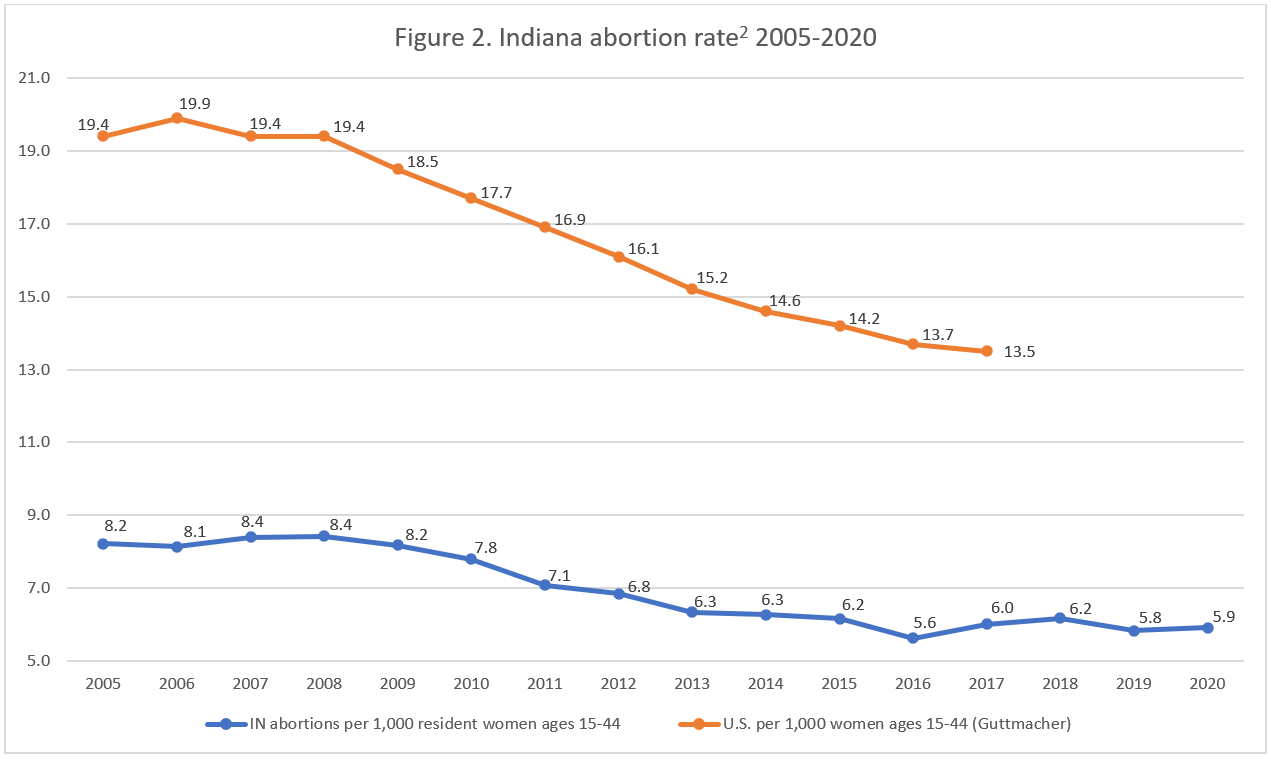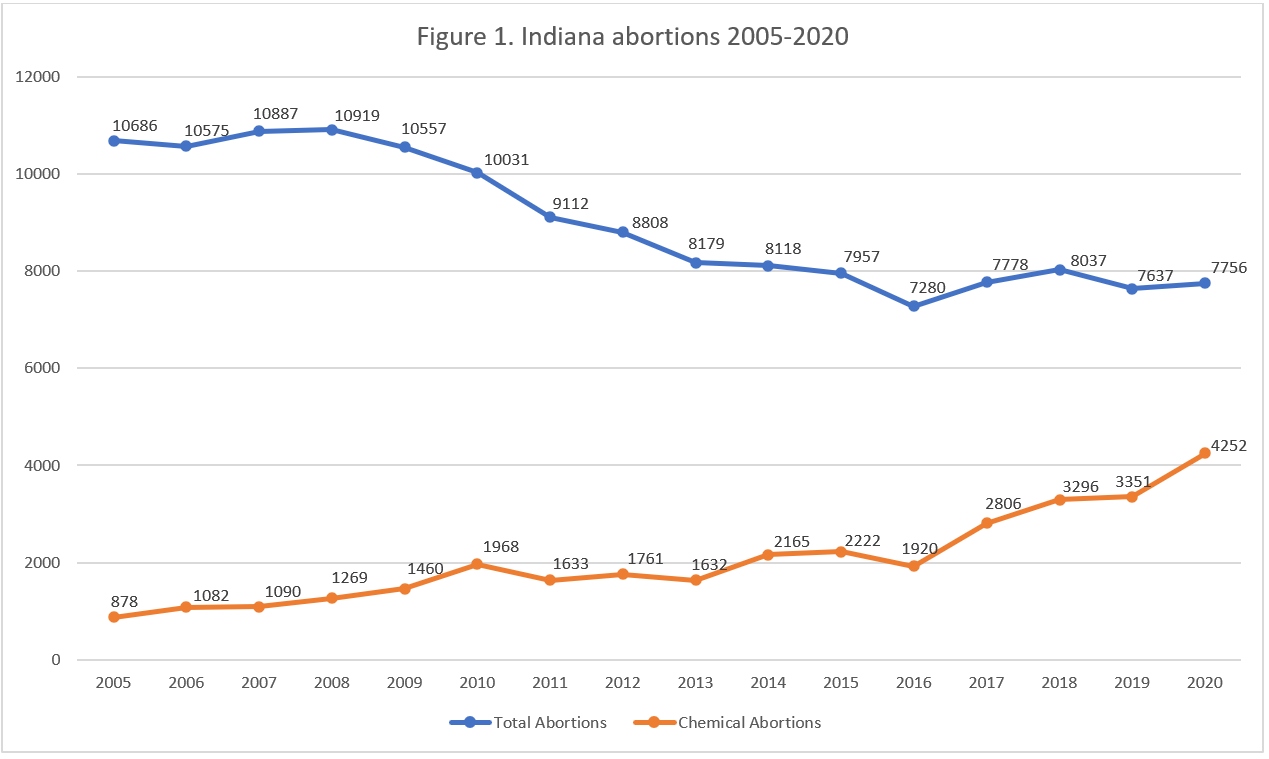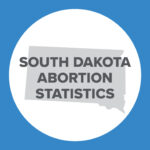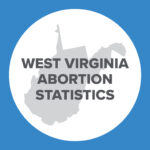Abortion Reporting: Indiana (2020)
Indiana’s 2020 abortion report was published online in July 2021, revealing that Indiana abortions increased from 2019.
Statistics and Changes in Indiana Abortions, 2019-2020

Abortion Totals and Trends
In 2020, there were 7,756 abortions reported in Indiana, up not quite two percent from the previous year. Chemical abortions jumped by 27 percent, making up over half of all abortions occurring in Indiana in 2020 (Fig. 1). The Charlotte Lozier Institute (CLI) estimates that Indiana’s 2020 abortion rate was 5.9 abortions per 1,000 women ages 15 to 44, still well below the national rate (Fig. 2). As of March 2022, 28 states had released 2020 abortion statistics, of which 19 reported that abortions had increased from 2019.
State Report Summary
In 2020, 95 percent of the abortions reported in Indiana were performed on state residents. Five percent were obtained by nonresident women, including three percent on women from Kentucky. Over half the abortions (59 percent) were on women in their twenties, with just under 31 percent performed on women ages 20 to 24 and 29 percent performed on women ages 25 to 29. Twenty-eight percent were performed on women in their thirties. Three percent of Indiana abortions were on women ages 40 and older, and nine percent were on girls under the age of 20.
Forty-nine percent of Indiana abortions were performed on white women. Thirty-five percent were on black women, and three percent were obtained by Asian women. Twenty-three abortions (0.3 percent) were performed on American Indian or Alaska Native women, and 13 abortions (0.2 percent) were on Native Hawaiian or Pacific Islander women. Ten percent of Indiana abortions were performed on women of other races, and one percent were performed on women of multiple races. Race was not reported for one percent of the abortions.
In 2020, nine percent of Indiana abortions were performed on women who had not completed high school. Thirty-seven percent were on women with a high school diploma or its equivalent, and 26 percent were obtained by women who had completed some college but did not have a degree. Twenty-seven percent of Indiana abortions were performed on women with a college degree. Level of education was unknown for two percent of the abortions.
Eighty-five percent of the abortions reported in Indiana were on unmarried women, while 15 percent were performed on married women. Thirty-eight percent of Indiana abortions were performed on women with no living children. A quarter were on women with one child, and 37 percent were on women with two or more children. Sixty-eight percent of the abortions were obtained by women with no previous abortions, compared to 21 percent on women with one prior abortion and 11 percent on women with more than one. Eighteen percent of the abortions were performed on women who had previously had a miscarriage.
Over half the abortions reported in Indiana, 55 percent, were chemical. Forty-five percent were surgical abortions. Twenty-seven percent of Indiana abortions occurred at six weeks of gestation or earlier. Forty-one percent were performed between seven and eight weeks, dropping to 31 percent between nine and 13 weeks. Relatively few abortions were reported after 13 weeks. There were 31 abortions between 14 and 19 weeks (0.4 percent), 12 abortions at 20 weeks, and 26 abortions at 21 weeks of gestation. Indiana limits abortion at 20 weeks post-fertilization, around 22 weeks of gestation. According to Indiana’s report, abortions after 13 weeks were performed at acute care hospitals.
More than half of Indiana abortions (55 percent) were performed in Planned Parenthood’s four Indiana abortion centers. A quarter were performed at The Women’s Med Center of Indianapolis, 14 percent occurred at Clinic for Women, and five percent were reported by Whole Woman’s Health of South Bend. One percent of the abortions occurred in hospitals. The month of January had the most abortions (753), and November had the fewest (529).
Abortion Complications
In 2018, Indiana passed a robust complication reporting law to require hospitals, physicians, and abortion centers to report any abortion-related complications they treat. However, the law was blocked by a court order and struck down in 2020. Indiana appealed to the U.S. Court of Appeals for the Seventh Circuit, which ultimately upheld the law, allowing it to finally go into effect in October 2021.
Despite the fact that the law was not in effect in 2020, reported complications increased that year.1 In 2019, 50 abortions were incomplete, or 0.7 percent of total abortions; all 50 had to be completed surgically. In 2020, there were 88 incomplete abortions, 1.1 percent of the total. Seventy-nine of these were completed surgically. For 2019 and 2020, 45 women experienced other complications each year. The reports do not indicate whether these were the same as the women who had the incomplete abortions or whether the complications were experienced by different women.
State Ranking
In 2016, CLI evaluated abortion reporting across the 50 states, New York City, and the District of Columbia, and Indiana’s reporting was ranked at fifth best. Indiana is working to further improve its reporting by defending its complication reporting law in court. Indiana could also strengthen its abortion statistics by reporting the types of procedures used in the state in more detail and breaking down chemical and surgical abortions by gestational age.


- Statistics on abortion complications reported here represent a minimal number of deaths and complications, as this data is collected in a non-systematic and non-verifiable way. As such, this data cannot be used to calculate either an accurate abortion mortality rate or an accurate abortion complication rate for the state.
- Rates were calculated by CLI using the following formula: (total number of abortions performed in Indiana ÷ number of resident women ages 15-44) x 1,000. Rates may differ slightly from previous CLI articles due to revised population estimates. Population estimates were obtained from the CDC WONDER database.
Percentages may not add to 100% due to rounding.

























